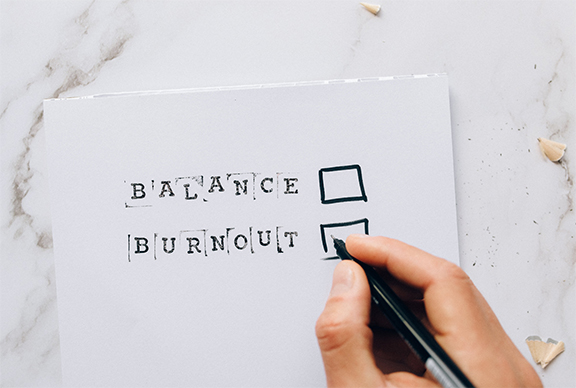
Can stress be a good thing? And when does it turn into distress overload?
Stress gets a bad rap. We say that work is stressful, the kids are stressing us out, there’s too much to do, and we need to learn better stress management. But what if stress isn’t all bad? What if we’ve become programmed to think of it as a negative, when in fact a little bit of stress might just be good for us?
What happens when we’re stressed?
Whenever we’re faced with an exciting or challenging situation, the nervous system switches into “fight or flight” mode. The adrenal glands pump out the stress hormones epinephrine and cortisol, which make your blood pressure rise, pulse increase, and pupils dilate. You might feel tension or butterflies in your stomach, and may need to dash to the bathroom.
These are all normal responses designed to heighten your senses and mobilize energy stores, so you can either handle the situation or get away from it. In cavewoman times, this would have meant dealing with a rampaging woolly mammoth; nowadays we’re faced with traffic jams, an angry boss, and sassy teens — not so easy to deal with or run away from.
Eustress describes any situation that invokes optimal levels of stimulation and results in a sense of growth, mastery, fulfillment, or achievement.

Can stress be a good thing?
Sometimes, yes. There’s a sweet spot on the scale of stress called “eustress”, which means “good stress”. First defined by the father of modern stress theory, Dr. Hans Selye, eustress describes any situation that invokes optimal levels of stimulation and results in a sense of growth, mastery, fulfillment, or achievement. This might be starting a new job, moving, giving a speech in public for the first time, or passing your driving test.
Alongside eustress, small amounts of uncomfortable stress or distress can also be beneficial. After all, the “fight or flight” response is designed to be protective, not harmful. For example, short bouts of stress can improve alertness and concentration. Ever noticed that a tight project deadline can make you come up with even better ideas? That’s the positive effect of stress hormones on the brain, heightening your performance.

Problems arise when too much eustress or distress tips over into chronic, ongoing distress. At this point, we no longer experience that warm glow of achievement or sense of growth, because the stressful situations are relentless and overwhelming.
From good stress to distress
Problems arise when too much eustress or distress tips over into chronic, ongoing distress. At this point, we no longer experience that warm glow of achievement or sense of growth, because the stressful situations are relentless and overwhelming. The challenges outstrip our capacity to cope. And rather than having short-term bursts of “fight or flight”, we become permanently stuck in this alarm state, unable to relax and rebalance.
Dr Selye calls this the ‘adaptation’ stage, when your body and mind are adjusting to ongoing stresses. The ratio of stress hormones shifts slightly as cortisol takes over and we become primed and alert for the next challenging situation or threat.
When the adaptation stage continues with no sign of relief, we risk becoming exhausted and burnt out. This is sometimes called “adrenal fatigue”, in recognition of the fact that the adrenal glands are struggling to keep up with the demand for stress hormones. You might also know it as HPTA axis dysfunction — a name that acknowledges the complex interactions between the hypothalamus and pituitary glands in the brain, and the adrenal and thyroid glands that work collectively to manage the stress response.
Chronically elevated stress hormones can cause:
- Poor memory and concentration. Over time stress hormones can alter the way the brain stores and retrieves memories, leading to that feeling of brain fog and poor recall.
- Weight gain around the middle. Cortisol instructs the body to store fat around the belly area.
- Increased risk of heart disease, high blood pressure, stroke, and Type II diabetes
- Fatigue
- Mood imbalances
- Hormone imbalances
- Insomnia
- Digestive problems, and more.
We are in a generational squeeze, sandwiched between caring for aging parents and young offspring. Each role carries its demands, and we’re called upon to find the time and resources to meet them all.
Why is midlife so stressful?
We can experience stress at any age, but there’s something about midlife that makes it even more intense. Soomi Lee, Assistant Professor of Aging Studies at the University of South Florida, writes that midlife is the time when we carry the greatest number of social roles. A midlifer has four key roles on average: worker (in employment and/or as a homemaker), parent, partner, and adult child. We are in a generational squeeze, sandwiched between caring for aging parents and young offspring. Each role carries its demands, and we’re called upon to find the time and resources to meet them all.
Women, trans men, and non-binary folk may also have the added demands of perimenopause and menopause. The ups and downs of estrogen and progesterone fluctuations can affect mood, memory, energy, sleep patterns, and mental well-being, making even regular levels of stress harder to cope with.
Former editor of Elle magazine Lorraine Candy, discusses the shifting “windows of tolerance” during perimenopause that affect women’s capacity to handle stress. Talking about her own experience of forgetting which side of the road to drive on while in perimenopause, she says that the low levels of estrogen in our brains at this point in life literally “scramble women’s neurology”.

5 signs of stress overload
So, how can you tell when you’re past the sweet spot for stress and heading toward burnout? Here are 5 key signs to look out for.
- You struggle with getting to sleep and waking up. Cortisol, the main stress hormone, follows a natural daily pattern that peaks at around 8 am and then declines slowly for the rest of the day. Chronic stress can disrupt this pattern, leaving you wired and alert late at night and sluggish in the morning.
- Craving carbohydrates: Glucose (sugar) is the body’s preferred form of fuel. The easiest way to get glucose is from refined carbohydrates like white bread, pasta, chips, sugary cakes, cookies, and sodas. When we’re under stress, cortisol programs the body to store fuel (i.e. sugars) and drives us towards carbohydrates by amplifying the sweet tastebuds on the tongue.
- Digestive symptoms: Bloating, indigestion, constipation, and diarrhea are all signs that stress is affecting your digestive function.
- Weight changes: Some people lose a lot of weight because of stress, while others gain the pounds easily, especially around the belly area.
- Frequent infections: Long-term stress lowers immunity, leaving you prone to bugs and viruses like colds, flu, and urinary tract infections.
The age-old saying “what doesn’t kill you makes you stronger” could not be more wrong when it comes to stress.

How to build resilience to stress without losing your mind
The age-old saying “what doesn’t kill you makes you stronger” could not be more wrong when it comes to stress. Despite what hustle culture would have us believe, there are no medals for being constantly busy and overwhelmed, just a long slow road back to recovery.
We may not be able to escape a demanding boss or the midlife generational squeeze but we can shift how we respond to these situations and build greater resilience. Here’s how:
- Practice saying no. As the popular quote goes, “No” is a complete sentence. This can be difficult when friends, family, and colleagues are used to you saying yes, but it’s the quickest way to reduce demands on your time.
- Learn to delegate. If you can’t easily say no, say yes, and then delegate!
- Be selfish with your downtime. This time is for you, it’s not for catching up on WhatsApp chats, writing grocery lists, or listening to your neighbor’s woes. Protect it from the time-stealers and make sure it’s just for you.
- Practice deep breathing. The quickest way to switch from “fight or flight” activation to “rest” mode is through deep belly breathing.
- Get regular daily movement. Yoga, walking, and Qi Gong are gentle forms of movement known to support mental well-being and emotional resilience. Try this yoga sequence designed to help caregivers develop resilience.
- Work on your sleep hygiene. From blackout blinds to cooling fans, there are lots of ways to create the right environment for a good night’s sleep.
- Enjoy a 20-minute morning walk. This is a great tip if you feel your cortisol levels are out of whack. Being out in the morning light helps the body reset its internal 24-hour clock and regulate cortisol levels, making it easier to wake up in the morning and fall asleep at night.
- Feed yourself well. Your body needs the right kinds of fuel to carry you through tough times, so that means limiting sugar, takeout, caffeine, and alcohol, and stocking up on whole grains, colorful fruits and vegetables, and good quality protein. Use meal kits, ready-diced frozen veggies, and pre-prepped salads if you’re pushed for time.
- Try kidulting! Research shows that playful adults are better equipped to manage stress and have improved well-being and life satisfaction. Find out how to be more kidult from Victoria Stokes.
Stress is a spectrum of different situations that we each respond to in unique ways. What causes me distress might be a form of eustress for you, and vice versa. Whether our stresses are positive or negative, we all need time and space to build our resilience — especially in midlife.
This article was originally published here on The Midst Substack.



